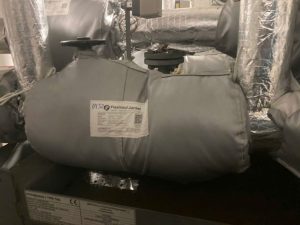In industrial piping systems, valves and fittings are often “weak points,” causing significant heat loss. Industrial valve insulation jackets (or insulation blankets) have emerged as a smart, removable insulation solution. This is a cost-effective investment that helps businesses optimize efficiency, save on energy costs, and most importantly, ensure absolute safety for operators.
What Are Industrial Valve Insulation Jackets?
Industrial valve insulation jackets, also known as insulation blankets or removable insulation covers, are products custom-designed and fabricated to fit snugly over various types of valves (gate valves, globe valves, ball valves…), joints, strainers, and other fittings on a pipeline.
Their primary purpose is to create a thermal barrier, keeping the temperature inside the equipment stable and preventing energy loss to the environment. Unlike permanent insulation that must be destroyed for maintenance, insulation jackets use a system of straps and dedicated fasteners, allowing for quick and easy removal and reinstallation without complex tools.
The Outstanding Benefits of Valve Insulation Jackets
Investing in insulation jackets for your valve and piping system brings many practical and measurable benefits.
1. Save Energy, Optimize Costs
The uninsulated surface of a valve is a major source of heat loss. An insulation jacket helps minimize this loss, thereby:
- Reduce energy costs: Heating or cooling systems will operate less to maintain the desired temperature.
- Optimize processes: Stable temperatures help production processes run consistently and achieve higher efficiency.
2. Enhance Workplace Safety
This is one of the most critical benefits, especially in harsh working environments:
- Prevent burn accidents: Insulation jackets lower the surface temperature of valves from dangerous levels (which can reach several hundred degrees Celsius) to a safe-to-touch level, minimizing the risk of burns to personnel.
- Reduce fire and explosion risks: They isolate hot equipment surfaces from flammable materials or gases in the environment.
3. Protect Equipment, Extend Lifespan
An insulation jacket acts as a protective shield, safeguarding valves and fittings from harmful environmental factors:
- Prevent corrosion: They prevent moisture and chemicals from coming into direct contact with the equipment surface.
- Mitigate weather impact: They help outdoor equipment operate stably despite rain, sun, or extreme temperatures.
4. Maximum Flexibility and Convenience
- Remove and install in minutes: Routine valve maintenance and inspection become extremely fast. Personnel can remove the insulation jacket, perform their tasks, and reinstall it easily, saving significant time and labor costs.
- Reusable multiple times: Made from durable materials, insulation jackets can be reused over many maintenance cycles, offering long-term economic benefits.
Detailed Construction of Valve Insulation Jackets
A high-quality insulation jacket is typically composed of three layers of specialized materials:
Outer Shell
This is the layer exposed to the environment, responsible for being waterproof, chemical-resistant, UV-resistant, and abrasion-resistant. Common materials include Silicone-coated fabric, Teflon (PTFE) fabric, or chemically-coated fiberglass cloth.
Insulation Layer (Core)
This is the most critical part, determining the product’s insulation capability. Depending on the temperature requirements, the following materials are used:
- Fiberglass Wool: The most common, offering good insulation at a reasonable cost.
- Ceramic Fiber Wool: Withstands extremely high temperatures.
- Mineral Wool (Rockwool): Provides good thermal and acoustic insulation.
- Aerogel: A high-performance insulation material that is ultra-thin and lightweight, used for the most demanding applications.
Inner Liner
This layer is in direct contact with the valve surface and must withstand the system’s operating temperature without causing corrosion. Commonly used materials are fiberglass cloth or stainless steel mesh.
Common Industrial Applications
Thanks to their flexibility and effectiveness, insulation jackets are widely used for various types of equipment across almost all industries:
- Types of Equipment: Industrial valves (globe, ball, gate, butterfly), strainers, flanges, flexible joints, elbows, pumps, accumulators, turbines…
- Industries:
- Thermal power plants, energy sector
- Chemical and petrochemical plants
- Food and beverage industry
- Pharmaceutical and medical sectors
- HVAC systems, industrial boilers
- Maritime and shipbuilding industries
Investing in industrial valve insulation jackets is a strategic decision that not only helps cut operational costs but also builds a safer and more efficient work environment. For advice on the most suitable solution, contact reputable suppliers.
Request consultation and quotation now!Frequently Asked Questions
Why use an insulation jacket instead of permanent insulation?
Because of its superior flexibility. An insulation jacket allows for quick removal and reinstallation for equipment maintenance without destroying the insulation layer, saving costs and time in the long run.
What temperature can a valve insulation jacket withstand?
It depends on the insulation material inside. Insulation jackets can be designed to withstand temperatures from sub-zero to over 1000°C, suitable for most industrial applications.
Is installing an insulation jacket complicated?
Not at all. Insulation jackets are designed for easy self-installation using the included strap and fastener system, without needing specialized tools.
Can insulation jackets be used outdoors?
Yes. The outer shell of an insulation jacket is typically made from waterproof, UV-resistant materials that can withstand harsh weather conditions, ensuring durability for outdoor installations.










